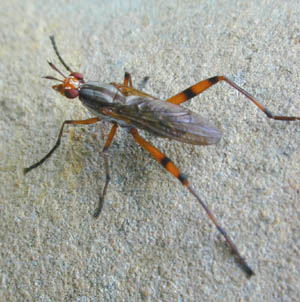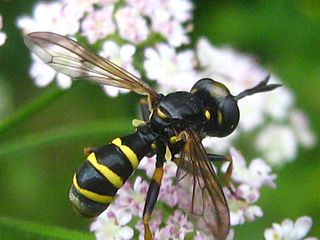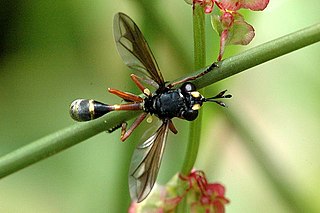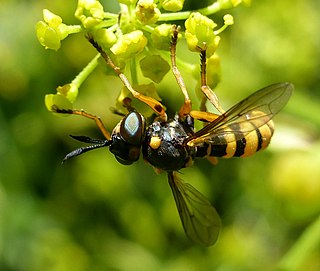| Sicini | |
|---|---|
 | |
| Sicus ferrugineus in copula | |
| Scientific classification | |
| Kingdom: | |
| Phylum: | |
| Class: | |
| Order: | |
| Family: | |
| Subfamily: | |
| Tribe: | Sicini Latreille, 1796 |
| Genera | |
See text | |
| Sicini | |
|---|---|
 | |
| Sicus ferrugineus in copula | |
| Scientific classification | |
| Kingdom: | |
| Phylum: | |
| Class: | |
| Order: | |
| Family: | |
| Subfamily: | |
| Tribe: | Sicini Latreille, 1796 |
| Genera | |
See text | |

The Acalyptratae or Acalyptrata are a subsection of the Schizophora, which are a section of the order Diptera, the "true flies". In various contexts the Acalyptratae also are referred to informally as the acalyptrate muscoids, or acalyptrates, as opposed to the Calyptratae. All forms of the name refer to the lack of calypters in the members of this subsection of flies. An alternative name, Acalypterae is current, though in minority usage. It was first used by Pierre-Justin-Marie Macquart in 1835 for a section of his tribe Muscides; he used it to refer to all acalyptrates plus scathophagids and phorids, but excluding Conopidae.

The Conopidae, usually known as the thick-headed flies, are a family of flies within the Brachycera suborder of Diptera, and the sole member of the superfamily Conopoidea. Flies of the family Conopidae are distributed worldwide in all the biogeographic realms except for the poles and many of the Pacific islands. About 800 species in 47 genera are described worldwide, about 70 of which are found in North America. The majority of conopids are black and yellow, or black and white, and often strikingly resemble wasps, bees, or flies of the family Syrphidae, themselves notable bee mimics. A conopid is most frequently found at flowers, feeding on nectar with its proboscis, which is often long.

Conops is a genus of flies from the family Conopidae. The larvae of Conops are parasitic on bees, especially bumblebees. Adults feed on nectar.

Conopini is a tribe of the flies family Conopidae. The larvae of species are parasitic on bees, especially bumblebees. Most adults will feed on nectar.

Physocephala rufipes is a species of fly from the genus Physocephala in the family Conopidae. Their larvae are endoparasites of bumble bees of the genus Bombus. It is common throughout much of Europe.

Conops flavipes is a species of fly from the genus Conops in the family Conopidae. Their larvae are endoparasites of bumble bees of the genus Bombus. It is common throughout much of Europe.

Myopa buccata is a species of fly from the genus Myopa in the family Conopidae. Their larvae are endoparasites of bumble bees of the genus Bombus. It is common throughout much of Europe.

Sicus is a genus of flies from the family Conopidae.

Zodion is a large genus of flies from the family Conopidae.

Conops strigatus is a species of fly from the genus Conops in the family Conopidae. Their larvae are endoparasites of bees and wasps. The fly is scarce in the United Kingdom.

Zodionini is a tribe of flies from the family Conopidae.

Myopinae is a subfamily of flies from the family Conopidae.

Myopini is a tribe of flies from the family Conopidae.

Conops vesicularis is a species of fly from the genus Conops in the family Conopidae. Their larvae are endoparasites of bees and wasps.

Physocephalini is a tribe of fly from the family Conopidae.

Conopinae is a subfamily of flies from the family Conopidae.

Physocephala nigra is a species of fly from the genus Physocephala in the family Conopidae. Their larvae are endoparasites of bumble bees of the genus Bombus.

Leopoldius brevirostris is a species of fly from the genus Leopoldius in the family Conopidae.

Leopoldius signatus is a species of fly from the genus Leopoldius in the family Conopidae.
Sicus abdominalis is a species of fly from the genus Sicus in the family Conopidae.